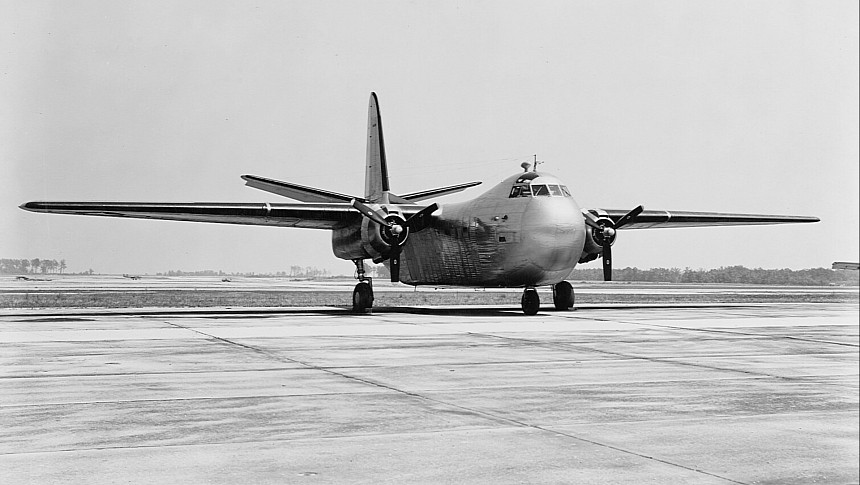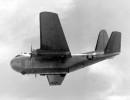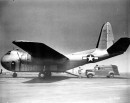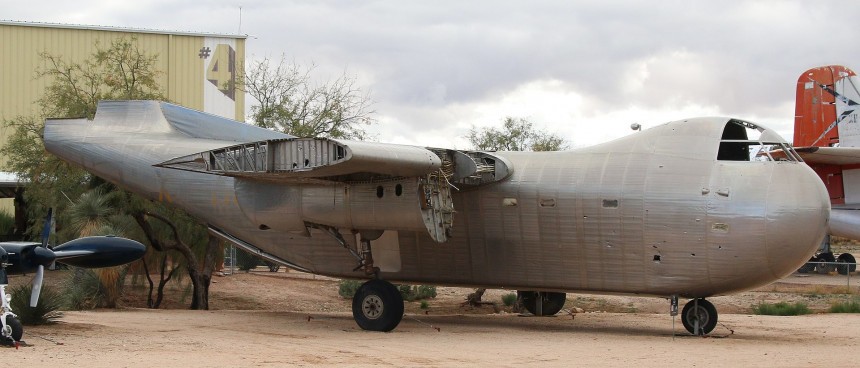Elon Musk might want you to believe he's a real genius for deciding to build SpaceX's Starship mostly out of stainless steel. He might hope you marvel at an ingenious use of high-quality build materials that, more often than not, aren't utilized to the full extent of their abilities. But don't be fooled; aircraft using high degrees of stainless steel in their construction are nothing novel at all. Want proof positive? Look no further than Budd RB-1 Conestoga, the mostly stainless steel cargo plane that walked so Starship could run.
To understand why a Philly-based metal fab known for manufacturing rail cars built a cargo plane out of something other than aerospace-grade aluminum, we must go back to the grueling middle period of World War II between 1941 and late 1943. At this time, the United States was not only supplying raw materials for its military initiatives in Europe, North Africa, and the Pacific, but also for all of its Allied nations in defense against Axis forces, which threatened to be subjugated in the result of their defeat.
Thousands upon thousands of tanks, trucks, crates of munitions, weapons, and aircraft poured off American assembly lines from New York to California and everywhere in between during this period. It was to the point where some in high-up positions within the Department of Defense's predecessor, the Department of War, questioned if it was possible to supply enough aluminum alloy to keep up with the biblical production figures these factories routinely kept to.
Could the United States straight up run out of aluminum before the war was over? It was a fear that some within the War Department lost sleep over at the time. Of course, such an apocalyptic scenario could've spelled disaster for the Allied nations if their manufacturing capability was brought into question for even a short period. But running around in panic and throwing in the towel was not on the agenda for the U.S.. Solutions of what to do in the worst-case scenario would need to be developed if fears about an aluminum alloy shortage were to be kept in check. Luckily, one company in particular was well suited for that job.
Headquartered in the Nicetown–Tioga neighborhood of North Philadelphia, the Budd Company was well suited to figuring out how to build military vehicles when stockpiles of aluminum were at critically low levels. Founded by the eccentric inventor Edward G. Budd in 1913, the Budd Company spent time before the war supplying bus bodies made entirely from pressed steel for companies around the world. Through their controlling stake in the Pressed Steel Company of Great Britain Limited, Budd provided these ultra-high-quality bodies to respected European names like Moris Motors and, ironically, Audi and BMW in Germany.
Budd was also heavily involved in designing the first American unibody passenger car, the Nash 600, which also used a high degree of steel in its construction. But, of course, the Budd Company is most well remembered for their high-quality rail cars, which saw service everywhere from New York to Chicago and Topeka to Santa Fe. Even into the 1980s, Budd was the gold standard in domestic passenger railcar production for New York's Metro North and Long Island Railroads. This considerable know-how in alternative metal materials would result in what became known as the RB-1 Conestoga.
Using a novel technique for welding SAE 304 stainless steel, which Budd called shot welding, two separate sheets of material could be clamped together before a searing-hot current of electricity was sent through the two pieces, joining them together without the need for aluminum rivets. The technique first cut its teeth on American domestic passenger railcars like the iconic Pioneer Zephyr, better known as the Silver Streak in enthusiast circles. The same technique would be vital to the RB-1 Conestoga's construction.
With dimensions of 68 feet (21 m) long and a 100-foot (30 m) wingspan, this 33,860 lb (15,359 kg) fully-loaded cargo plane could carry a wide variety of payloads in a combat setting. Everything from a single 1.5-ton truck to a full-sized ambulance and up to 24 paratroopers or 24 medical stretchers in its airborne ambulance configuration were trialed after the RB-1 Conestoga's first flight on October 31st, 1943. With its then-innovative tricycle-style landing gear, loading and off-loading cargo via the RB-1's rear door was done with a minimum of fuss or difficulty.
Powering this novel stainless steel warbird was a set of two Pratt & Whitney R-1830 Twin Wasp 14-cylinder radial engines. It was the same engine that powered icons of World War II aviation, like the Grumman F4F Wildcat navy fighter, the Consolidated B-24 Liberator bomber, and the Douglas C-47 Skytrain cargo transport. With its fuel capacity of just under 1000 U.S. gallons, the RB-1 could ferry its cargo over a distance of 1,620 miles (1,410 nmi; 2,610 km) on a light load and around 700 miles (1,100 km, 610 nmi) with a full-sized load.
With a takeoff distance from a dead standstill of just 650 feet (200 m) when unladen and 920 feet (280 m) with a load of just over ten thousand pounds in the cargo hold, the RB-1 helped perfect short takeoff and landing (STOL) before it was the cool thing to do. On paper, it looked like the Budd Company had well and truly solved the issue of how to manufacture warplanes with a bare minimum of aluminum in its construction. Had it come down to it, everything from trucks to components for firearms and even tanks could have been manufactured using the same techniques.
But as World War II progressed into its final stages, something remarkable happened. Instead of running into a critical deficit of aluminum, production of this vital wartime commodity only increased. At least as far as American domestic production was concerned, the Department of War's fears about a catastrophic shortage turned out to be little more than justifiable paranoia on the part of the U.S. Military. With these results apparent by the coming of early 1944, the U.S. Army Air Corps' order for 200 Budd RB-1s was slashed to just 20 examples, of which only 17 were delivered.
Ultimately, the RB-1 never saw service in World War II across any of its theaters. But a handful were delivered to domestic U.S. Navy bases and were used as tactical cargo transports before the War Department sold the remaining rolling stock to private American cargo transport firms like the National Skyway Freight Corp. The company purchased 12 RB-1s for the sum of $28,642 each, or around $346,300 in modern money. At a considerable discount compared to Douglas C-47s, which sold for the equivalent of $1.2 million in modern money at the time, the handful of RB-1s built did at least get some use out of their airframes.
One RB-1 was sold to the iconic Tucker Motor Company for the purposes of transporting its prototype 1948 Tucker Sedan after the war, as well as to the Flying Tiger Line airline company. One more was sold to the V.A.S.D. (Viação Aérea Santos Dumont) firm of Brazil, but it wasn't enough to keep the RB-1 a relevant airframe much past the end of World War II. Today, only a single, mostly unrestored RB-1 Conestoga survives. It's on display with both of its engines removed at the Pima Air & Space Museum in Tucson, Arizona, along with a host of other aircraft the U.S. Military has discarded over the last 50 years.
Even 80 years after its first flight, the sole surviving RB-1's stainless steel body remains relatively free of rust. Proving that even though stainless steel warbirds never quite "took off," they did at least have their virtues. It's to the point where one eccentric billionaire aviator with dreams of mass Starship production makes use of techniques Budd's own designers would no doubt identify with.
Thousands upon thousands of tanks, trucks, crates of munitions, weapons, and aircraft poured off American assembly lines from New York to California and everywhere in between during this period. It was to the point where some in high-up positions within the Department of Defense's predecessor, the Department of War, questioned if it was possible to supply enough aluminum alloy to keep up with the biblical production figures these factories routinely kept to.
Could the United States straight up run out of aluminum before the war was over? It was a fear that some within the War Department lost sleep over at the time. Of course, such an apocalyptic scenario could've spelled disaster for the Allied nations if their manufacturing capability was brought into question for even a short period. But running around in panic and throwing in the towel was not on the agenda for the U.S.. Solutions of what to do in the worst-case scenario would need to be developed if fears about an aluminum alloy shortage were to be kept in check. Luckily, one company in particular was well suited for that job.
Headquartered in the Nicetown–Tioga neighborhood of North Philadelphia, the Budd Company was well suited to figuring out how to build military vehicles when stockpiles of aluminum were at critically low levels. Founded by the eccentric inventor Edward G. Budd in 1913, the Budd Company spent time before the war supplying bus bodies made entirely from pressed steel for companies around the world. Through their controlling stake in the Pressed Steel Company of Great Britain Limited, Budd provided these ultra-high-quality bodies to respected European names like Moris Motors and, ironically, Audi and BMW in Germany.
Using a novel technique for welding SAE 304 stainless steel, which Budd called shot welding, two separate sheets of material could be clamped together before a searing-hot current of electricity was sent through the two pieces, joining them together without the need for aluminum rivets. The technique first cut its teeth on American domestic passenger railcars like the iconic Pioneer Zephyr, better known as the Silver Streak in enthusiast circles. The same technique would be vital to the RB-1 Conestoga's construction.
With dimensions of 68 feet (21 m) long and a 100-foot (30 m) wingspan, this 33,860 lb (15,359 kg) fully-loaded cargo plane could carry a wide variety of payloads in a combat setting. Everything from a single 1.5-ton truck to a full-sized ambulance and up to 24 paratroopers or 24 medical stretchers in its airborne ambulance configuration were trialed after the RB-1 Conestoga's first flight on October 31st, 1943. With its then-innovative tricycle-style landing gear, loading and off-loading cargo via the RB-1's rear door was done with a minimum of fuss or difficulty.
Powering this novel stainless steel warbird was a set of two Pratt & Whitney R-1830 Twin Wasp 14-cylinder radial engines. It was the same engine that powered icons of World War II aviation, like the Grumman F4F Wildcat navy fighter, the Consolidated B-24 Liberator bomber, and the Douglas C-47 Skytrain cargo transport. With its fuel capacity of just under 1000 U.S. gallons, the RB-1 could ferry its cargo over a distance of 1,620 miles (1,410 nmi; 2,610 km) on a light load and around 700 miles (1,100 km, 610 nmi) with a full-sized load.
But as World War II progressed into its final stages, something remarkable happened. Instead of running into a critical deficit of aluminum, production of this vital wartime commodity only increased. At least as far as American domestic production was concerned, the Department of War's fears about a catastrophic shortage turned out to be little more than justifiable paranoia on the part of the U.S. Military. With these results apparent by the coming of early 1944, the U.S. Army Air Corps' order for 200 Budd RB-1s was slashed to just 20 examples, of which only 17 were delivered.
Ultimately, the RB-1 never saw service in World War II across any of its theaters. But a handful were delivered to domestic U.S. Navy bases and were used as tactical cargo transports before the War Department sold the remaining rolling stock to private American cargo transport firms like the National Skyway Freight Corp. The company purchased 12 RB-1s for the sum of $28,642 each, or around $346,300 in modern money. At a considerable discount compared to Douglas C-47s, which sold for the equivalent of $1.2 million in modern money at the time, the handful of RB-1s built did at least get some use out of their airframes.
One RB-1 was sold to the iconic Tucker Motor Company for the purposes of transporting its prototype 1948 Tucker Sedan after the war, as well as to the Flying Tiger Line airline company. One more was sold to the V.A.S.D. (Viação Aérea Santos Dumont) firm of Brazil, but it wasn't enough to keep the RB-1 a relevant airframe much past the end of World War II. Today, only a single, mostly unrestored RB-1 Conestoga survives. It's on display with both of its engines removed at the Pima Air & Space Museum in Tucson, Arizona, along with a host of other aircraft the U.S. Military has discarded over the last 50 years.








